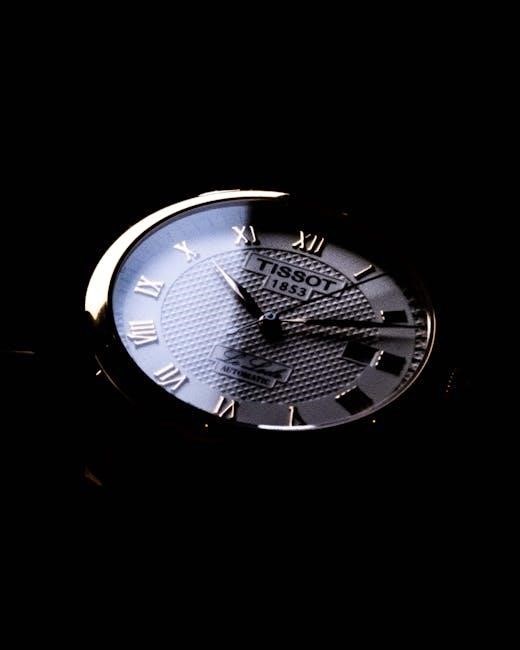Manual and automatic watches are two distinct types of mechanical timepieces. Manual watches require hand-winding, offering a personal connection, while automatic watches use the wearer’s movement for convenience. Both eliminate battery dependence, blending tradition with functionality.
Understanding the Basics of Manual Watches
A manual watch, also known as a hand-wound watch, requires the wearer to wind it by turning the crown. This action tightens the mainspring, which powers the watch. Unlike automatic watches, manual watches do not use a rotor to generate energy, relying instead on direct user input. They are known for their simplicity and lack of complex mechanisms, making them more accessible and often more affordable. Regular winding is essential to keep the watch functioning, typically requiring daily attention. This process creates a direct, personal connection to the timepiece.
Understanding the Basics of Automatic Watches
An automatic watch, also known as a self-winding watch, uses the wearer’s movement to wind its mainspring, eliminating the need for manual winding. This mechanism relies on a rotor that oscillates with the wearer’s arm movements, transferring energy to the spring. Automatic watches are designed for convenience, as they do not require daily winding if worn regularly. They are ideal for those seeking a low-maintenance timepiece that combines functionality with elegance, appealing to both casual users and watch enthusiasts alike.
Mechanics of Manual and Automatic Watches
Manual watches rely on hand-winding to power the mainspring, while automatic watches use a rotor to harness kinetic energy from the wearer’s movement, ensuring constant operation.
Mechanical Watch Movement: Manual Winding
A manual winding watch requires the wearer to turn the crown regularly to tighten the mainspring. This action stores energy, which powers the watch. The process is straightforward, involving fewer components than automatic watches, making manual movements simpler and often more affordable. The direct interaction with the watch creates a personal connection, appealing to enthusiasts who appreciate tradition. However, manual watches need consistent winding to maintain accuracy, typically requiring daily attention to ensure reliable timekeeping. This hands-on approach is a defining feature of manual winding timepieces.
Mechanical Watch Movement: Automatic Winding
An automatic watch features a self-winding mechanism that harnesses energy from the wearer’s movements. A rotor inside the watch oscillates, winding the mainspring and storing energy. This eliminates the need for manual winding, offering unparalleled convenience; The automatic movement is more complex, with additional components like the rotor, which can lead to a thicker design. Despite this, the mechanism ensures consistent power delivery, contributing to better accuracy over time. This innovation makes automatic watches ideal for daily use, as they require minimal user intervention to maintain precise timekeeping effortlessly.
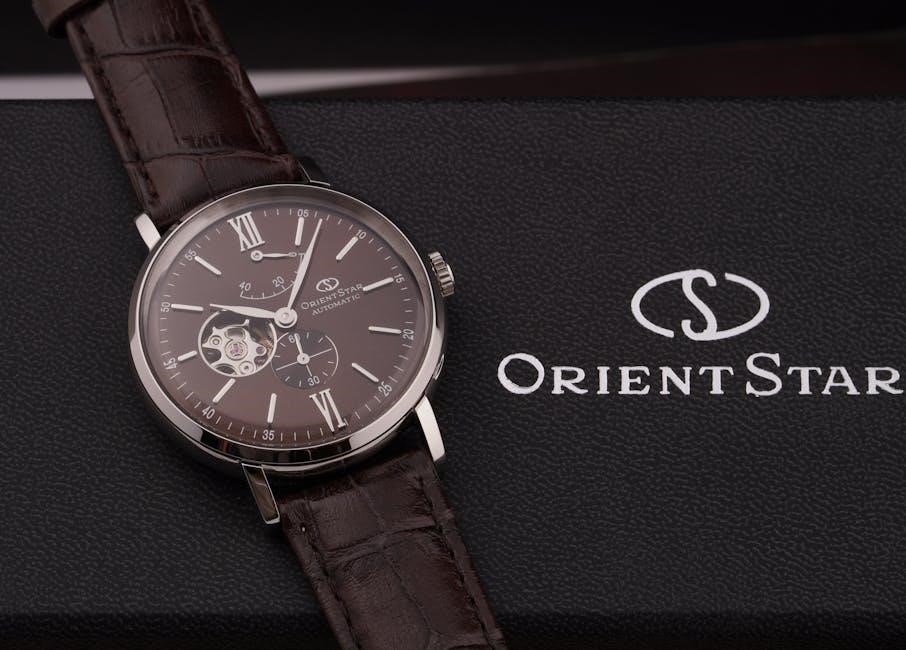
Advantages of Manual Watches
Manual watches offer simplicity, a personal winding ritual, and sleek designs. They are often more affordable, with fewer components, appealing to enthusiasts seeking timeless style and craftsmanship.
Cost-Effectiveness of Manual Watches
Manual watches are generally more affordable than automatic watches due to their simpler mechanisms. With fewer components, they require less intricate craftsmanship, reducing production costs. This makes them accessible to a wider audience. Additionally, manual watches often retain their value well, offering a practical choice for those seeking a reliable timepiece without the premium pricing of automatic watches. Their cost-effectiveness appeals to both new collectors and seasoned enthusiasts looking for a budget-friendly option.
Simplicity and Reliability
Manual watches are praised for their simplicity and reliability. With fewer components compared to automatic watches, they are less prone to mechanical issues. The absence of a self-winding rotor results in a slimmer design and reduced complexity, making them more durable over time. While they require regular winding, this straightforward mechanism ensures consistent performance. Their reliability makes them a preferred choice for those seeking a hassle-free timepiece.
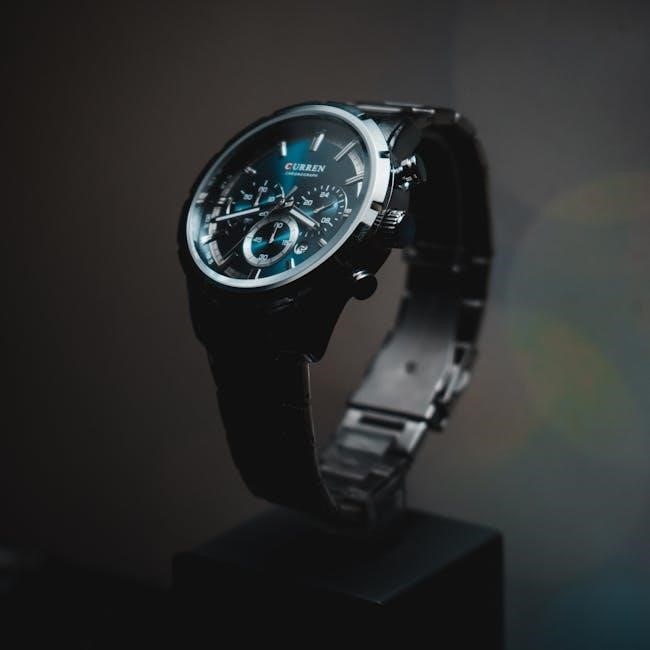
Advantages of Automatic Watches
Automatic watches offer unmatched convenience and consistency. Their self-winding mechanism eliminates the need for manual winding, making them ideal for daily wear without interruption or effort.
Convenience of Self-Winding Mechanism
Automatic watches offer unparalleled convenience through their self-winding mechanism. The rotor harnesses the wearer’s movement to wind the spring, eliminating the need for manual winding. This feature is ideal for individuals who value ease of use and prefer not to interrupt their daily routine with manual adjustments. The self-winding system ensures the watch remains powered as long as it is worn regularly, providing a seamless and hassle-free timekeeping experience. This convenience makes automatic watches a practical choice for everyday wear.
Accuracy and Consistency
Automatic watches are generally more accurate than manual watches due to their consistent power reserve. The self-winding mechanism ensures the spring remains at a stable tension, reducing timing variations. This consistency is particularly noticeable when the watch is worn regularly, as the rotor continuously replenishes the power. In contrast, manual watches may experience fluctuations in accuracy if not wound properly or consistently. The steady energy supply in automatic watches contributes to their reputation for reliability and precision in timekeeping.
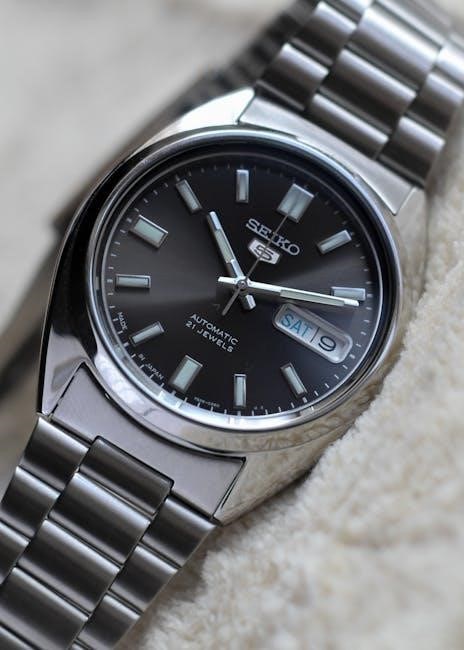
Disadvantages of Manual Watches
Manual watches demand regular winding, which can be inconvenient. Forgetting to wind them results in stopped functionality. Inconsistent winding may lead to irregular power reserve levels.
Necessity of Regular Winding
Manual watches require frequent winding, typically daily or every few days, depending on the power reserve. Neglecting this routine results in the watch stopping, requiring manual restart. This dependency on the wearer’s diligence can be inconvenient, especially for those with busy lifestyles. Automatic watches, by contrast, eliminate this need through their self-winding mechanism. Regular winding ensures consistent timekeeping but demands consistent user interaction, making manual watches less practical for everyday wear compared to their automatic counterparts. This maintenance requirement is a notable disadvantage for many users.
Potential for Inconsistent Power Reserve
Manual watches can experience inconsistent power reserves due to irregular winding habits. If not wound consistently, the spring’s tension may vary, affecting timekeeping accuracy. This reliance on manual intervention can lead to fluctuations in performance, especially if the watch is not wound fully or regularly. In contrast, automatic watches maintain a stable power reserve through continuous self-winding, reducing the risk of such inconsistencies. This makes manual watches more sensitive to user behavior, potentially impacting their reliability and precision over time.
Disadvantages of Automatic Watches
Automatic watches are typically more expensive due to their complex self-winding mechanism and often feature thicker designs because of the rotor. These factors may deter some users.
Higher Cost Due to Complex Mechanism
Automatic watches are generally more expensive than manual watches due to their intricate self-winding mechanism. The addition of a rotor and additional components increases production complexity and cost. This makes automatic watches less accessible to budget-conscious buyers, despite their convenience and appeal. The higher price reflects the engineering and craftsmanship required to create a reliable and efficient automatic movement, making them a luxury item for many enthusiasts.
Thicker Design Due to Rotor
Automatic watches often have a thicker design compared to manual watches due to the self-winding rotor. This component, which oscillates to generate power, adds depth to the case. While this doesn’t affect functionality, it can influence style preferences. Manual watches, lacking this mechanism, tend to be sleeker and more lightweight. The rotor’s presence in automatics makes them slightly bulkier, which some users find less comfortable or less aesthetically pleasing.

Cost Considerations
Manual watches are generally more affordable due to their simpler mechanisms, while automatic watches are pricier because of the complex self-winding rotor system.
Price Range of Manual Watches
Manual watches are often more affordable due to their simpler mechanisms. Entry-level models can start around $200–$500, offering basic timekeeping functionality. Mid-range options, typically from established brands, may cost between $1,000–$3,000, featuring high-quality craftsmanship. Luxury manual watches, such as those from Patek Philippe or Vacheron Constantin, can range from $10,000 to $50,000 or more, depending on complications and exclusivity. Prices vary based on brand reputation, movement quality, and design complexity, making manual watches accessible to both budget-conscious buyers and collectors seeking precision and elegance.
Price Range of Automatic Watches
Automatic watches tend to be more expensive due to their complex self-winding mechanisms. Entry-level automatic watches start around $500–$1,000, offering reliable performance. Mid-range models, often from well-known brands like Tissot or Seiko, can range from $1,500–$5,000, combining quality and style. Luxury automatic watches, such as Rolex or Omega, typically range from $5,000 to $20,000 or more, with high-end complications reaching upwards of $50,000. The intricate engineering and additional components drive the higher cost, appealing to enthusiasts who value precision and craftsmanship.
Maintenance and Upkeep
Manual watches generally require less maintenance due to their simpler mechanisms, while automatic watches need periodic servicing to ensure the self-winding system functions optimally;
Maintenance Requirements for Manual Watches
Manual watches require regular winding, typically done by hand or with a tool. Service every 3-5 years is recommended to ensure accuracy. Protect from magnetic fields and store properly when not in use. This ensures longevity and optimal performance.
Maintenance Requirements for Automatic Watches
Automatic watches demand less frequent user interaction but still need regular maintenance. Service every 5-7 years is essential to maintain accuracy. Avoid extreme temperatures and magnetic fields. Ensure the watch is wound when not worn for extended periods. Proper care ensures the rotor functions efficiently, preserving the timepiece’s reliability and longevity.
Accuracy Comparison
Automatic watches are slightly more accurate than manual watches due to consistent power reserve from the self-winding mechanism, ensuring a stable energy supply for precise timekeeping.
Accuracy of Manual Watches
Manual watches can be highly accurate, but their precision depends on consistent winding and proper maintenance. Since they rely on manual winding, the power reserve gradually depletes, potentially affecting accuracy over time. However, high-quality manual movements are designed to maintain precision throughout their power cycle. While they may not offer the consistent energy supply of automatic watches, manual watches are favored for their simplicity and mechanical purity, appealing to enthusiasts who appreciate traditional craftsmanship and direct interaction with their timepiece.
Accuracy of Automatic Watches
Automatic watches are often praised for their accuracy due to the consistent energy provided by the self-winding mechanism. The rotor ensures the mainspring remains at a stable tension, which can enhance precision. While minor variations may occur, automatic movements generally maintain accuracy as long as they are regularly worn and serviced; This consistency makes them a practical choice for everyday use, offering reliability without the need for frequent adjustments or manual intervention.
Lifestyle Considerations
Your lifestyle determines the best watch choice. Manual watches suit occasional use, offering a tangible connection. Automatic watches excel for daily wear, providing effortless convenience without constant winding, aligning seamlessly with active routines.
Manual Watches for Occasional Use
Manual watches are ideal for occasional use, offering a unique, tactile experience. They require deliberate winding, fostering a personal connection. This makes them perfect for special events or when not worn daily. Their simplicity ensures reliability, and they often come at a lower cost. However, they need regular winding to maintain accuracy, which can be a drawback for frequent use. Despite this, they remain a popular choice for collectors and those who appreciate tradition and craftsmanship in horology.
Automatic Watches for Daily Use
Automatic watches are perfectly suited for daily use due to their self-winding mechanism, which eliminates the need for manual winding. This convenience makes them ideal for individuals who value practicality and minimal maintenance. The consistent power reserve ensures accuracy, and they often come with additional features. However, their complexity and higher cost can be a downside. Despite this, their reliability and ease of use make them a favorite among those seeking a timepiece that keeps up with their active lifestyle without constant intervention.
Aesthetic Appeal
Manual watches are sleek and thin, appealing for their minimalist design, while automatic watches often feature intricate details and a luxurious finish, making both popular in high-end collections.
Design Differences Between Manual and Automatic Watches
Manual watches are typically slimmer and lighter due to the absence of a rotor, offering a sleek, minimalist aesthetic. Automatic watches, while slightly thicker, feature a rotor mechanism visible through transparent cases, adding complexity and visual intrigue. Manual watches often emphasize clean lines and timeless elegance, while automatics showcase intricate engineering, appealing to those who appreciate mechanical sophistication. Both designs cater to different tastes, with manual watches favoring understatement and automatics highlighting craftsmanship.
Popularity in Luxury Watch Collections
Both manual and automatic watches hold prestigious places in luxury collections. Manual watches are often favored by purists who appreciate the tactile experience of winding. Automatics, with their self-winding convenience, are sought after for daily wear. High-end brands frequently feature both types, with automatics like Rolex’s Perpetual movements gaining iconic status. Manual watches, however, remain exclusive and desirable for their simplicity and historical significance. Collectors often value both for their unique appeal, making them integral to luxury watch portfolios.
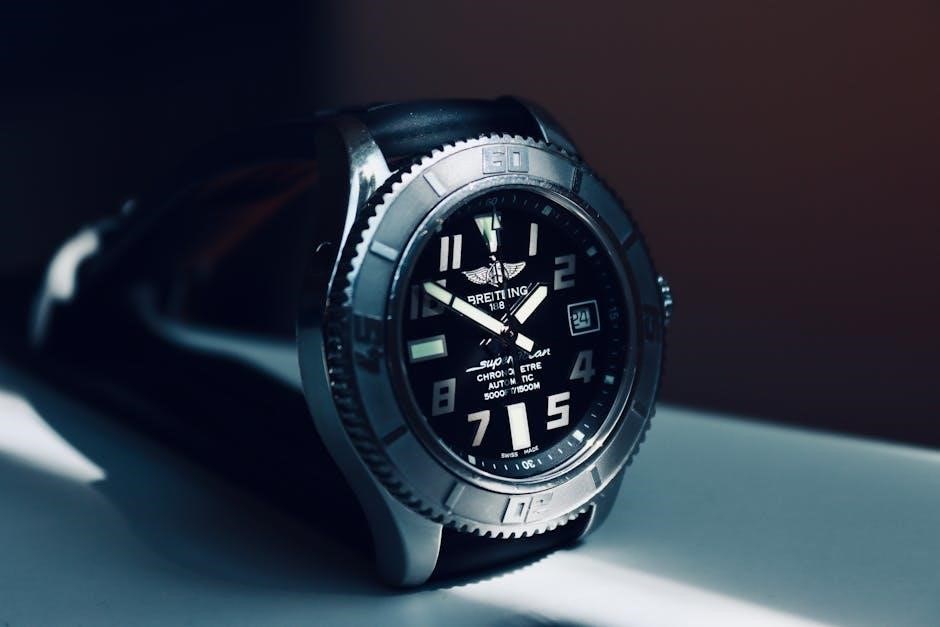
Historical Context
Manual watches preceded automatics, requiring daily winding, while automatics emerged later, innovated by figures like John Harwood, offering self-winding convenience that gained popularity over time.
Evolution of Manual Watches
Manual watches trace their origins to the 16th century, evolving from pocket watches. Over time, they became more precise, with improvements in escapements and gear trains by the 19th century.
Though overshadowed by automatic watches in the 20th century, manual watches remain cherished for their craftsmanship and tactile experience, appealing to collectors who value tradition and mechanical artistry.
Evolution of Automatic Watches
Automatic watches emerged in the early 20th century, revolutionizing horology with self-winding mechanisms. The invention of the rotor by Swiss watchmaker Abraham-Louis Perrelet laid the foundation for modern automatic movements.
Over decades, automatic watches became more refined, with advancements in accuracy and reliability. They gained popularity for their convenience, especially for everyday use, and remain a cornerstone of luxury watchmaking, blending innovation with timeless elegance.

Choosing the Right Watch
Selecting between a manual or automatic watch depends on your lifestyle and preferences. Consider factors like convenience, budget, and personal connection to the timepiece.
Factors to Consider for Manual Watches
When choosing a manual watch, consider your lifestyle and commitment to daily winding. Manual watches are ideal for occasional use or collectors who appreciate the tactile experience. They are generally more affordable and offer a slimmer design compared to automatic watches. However, they require regular winding to maintain accuracy and functionality. If you value simplicity and a direct connection to your timepiece, a manual watch may be the perfect choice.
Factors to Consider for Automatic Watches
Automatic watches are ideal for daily wear due to their self-winding convenience. They eliminate the need for manual winding, making them perfect for active individuals. The rotor mechanism ensures consistent power reserve, enhancing accuracy. However, automatic watches are generally thicker and more expensive due to their complex design. Maintenance costs may also be higher. If you value convenience, accuracy, and a hassle-free experience, an automatic watch is a suitable choice, especially for frequent use;
Manual and automatic watches cater to different preferences. Manual watches offer simplicity and affordability, while automatic watches provide convenience and accuracy. Choose based on your lifestyle and priorities.
Final Thoughts on Manual vs Automatic Watches
Manual and automatic watches each have unique appeal. Manual watches offer a tactile experience, with daily winding fostering a connection, while automatic watches provide seamless convenience. Both are masterpieces of horology, with manual watches often being more affordable and thinner, and automatics excelling in accuracy and ease of use. Your choice depends on lifestyle, budget, and personal preference. Balancing cost, convenience, and design, these timepieces cater to diverse needs and tastes, ensuring timeless elegance on the wrist.
